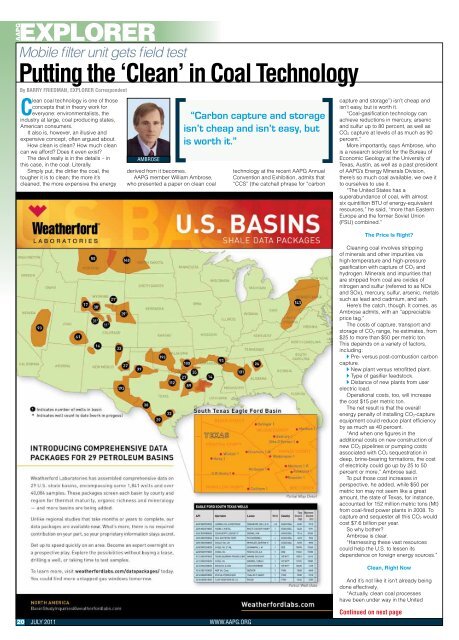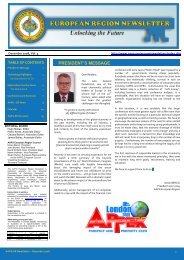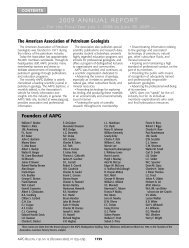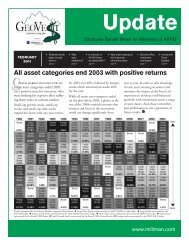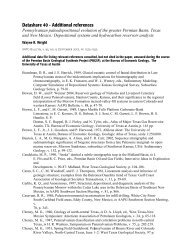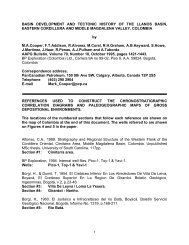AAPG Explorer - American Association of Petroleum Geologists
AAPG Explorer - American Association of Petroleum Geologists
AAPG Explorer - American Association of Petroleum Geologists
You also want an ePaper? Increase the reach of your titles
YUMPU automatically turns print PDFs into web optimized ePapers that Google loves.
<strong>AAPG</strong><br />
EXPLORER<br />
Mobile filter unit gets field test<br />
Putting the ‘Clean’ in Coal Technology<br />
By BARRY FRIEDMAN, EXPLORER Correspondent<br />
Clean coal technology is one <strong>of</strong> those<br />
concepts that in theory work for<br />
everyone: environmentalists, the<br />
industry at large, coal producing states,<br />
<strong>American</strong> consumers.<br />
It also is, however, an illusive and<br />
expensive concept, <strong>of</strong>ten argued about.<br />
How clean is clean? How much clean<br />
can we afford? Does it even exist?<br />
The devil really is in the details – in<br />
this case, in the coal. Literally.<br />
Simply put, the dirtier the coal, the<br />
tougher it is to clean; the more it’s<br />
cleaned, the more expensive the energy<br />
AMBROSE<br />
derived from it becomes.<br />
<strong>AAPG</strong> member William Ambrose,<br />
who presented a paper on clean coal<br />
20 JULY 2011 WWW.<strong>AAPG</strong>.ORG<br />
“Carbon capture and storage<br />
isn’t cheap and isn’t easy, but<br />
is worth it.”<br />
technology at the recent <strong>AAPG</strong> Annual<br />
Convention and Exhibition, admits that<br />
“CCS” (the catchall phrase for “carbon<br />
capture and storage”) isn’t cheap and<br />
isn’t easy, but is worth it.<br />
“Coal-gasification technology can<br />
achieve reductions in mercury, arsenic<br />
and sulfur up to 80 percent, as well as<br />
CO2 capture at levels <strong>of</strong> as much as 90<br />
percent.”<br />
More importantly, says Ambrose, who<br />
is a research scientist for the Bureau <strong>of</strong><br />
Economic Geology at the University <strong>of</strong><br />
Texas, Austin, as well as a past president<br />
<strong>of</strong> <strong>AAPG</strong>’s Energy Minerals Division,<br />
there’s so much coal available, we owe it<br />
to ourselves to use it.<br />
“The United States has a<br />
superabundance <strong>of</strong> coal, with almost<br />
six quintillion BTU <strong>of</strong> energy-equivalent<br />
resources,” he said, “more than Eastern<br />
Europe and the former Soviet Union<br />
(FSU) combined.”<br />
The Price Is Right?<br />
Cleaning coal involves stripping<br />
<strong>of</strong> minerals and other impurities via<br />
high-temperature and high-pressure<br />
gasification with capture <strong>of</strong> CO2 and<br />
hydrogen. Minerals and impurities that<br />
are stripped from coal are oxides <strong>of</strong><br />
nitrogen and sulfur (referred to as NOx<br />
and SOx), mercury, sulfur, arsenic, metals<br />
such as lead and cadmium, and ash.<br />
Here’s the catch, though. It comes, as<br />
Ambrose admits, with an “appreciable<br />
price tag.”<br />
The costs <strong>of</strong> capture, transport and<br />
storage <strong>of</strong> CO2 range, he estimates, from<br />
$25 to more than $50 per metric ton.<br />
This depends on a variety <strong>of</strong> factors,<br />
including:<br />
u Pre- versus post-combustion carbon<br />
capture.<br />
u New plant versus retr<strong>of</strong>itted plant.<br />
u Type <strong>of</strong> gasifier feedstock.<br />
u Distance <strong>of</strong> new plants from user<br />
electric load.<br />
Operational costs, too, will increase<br />
the cost $15 per metric ton.<br />
The net result is that the overall<br />
energy penalty <strong>of</strong> installing CO2-capture<br />
equipment could reduce plant efficiency<br />
by as much as 40 percent.<br />
“And when one figures in the<br />
additional costs on new construction <strong>of</strong><br />
new CO2 pipelines or pumping costs<br />
associated with CO2 sequestration in<br />
deep, brine-bearing formations, the cost<br />
<strong>of</strong> electricity could go up by 25 to 50<br />
percent or more,” Ambrose said.<br />
To put those cost increases in<br />
perspective, he added, while $50 per<br />
metric ton may not seem like a great<br />
amount, the state <strong>of</strong> Texas, for instance,<br />
accounted for 152 million metric tons (Mt)<br />
from coal-fired power plants in 2008. To<br />
capture and sequester all this CO2 would<br />
cost $7.6 billion per year.<br />
So why bother?<br />
Ambrose is clear.<br />
“Harnessing these vast resources<br />
could help the U.S. to lessen its<br />
dependence on foreign energy sources.”<br />
Clean, Right Now<br />
And it’s not like it isn’t already being<br />
done effectively.<br />
“Actually, clean coal processes<br />
have been under way in the United<br />
Continued on next page


